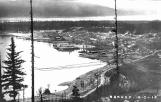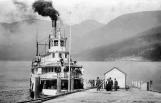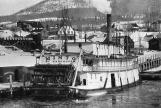1
A fairly serious downturn in the mining industry during the 1910's kept the Lardeau in slow growth, a mill at Gerrard providing much of the employment. Always subject to instant shut down, the closure of mines impacted communities often to the point of creating a ghost town. Diversity in industrial ventures adjoined with horticultural enterprise was a better balance for any town and certainly in a port town like Nakusp. Roadwork branching out from settlements along the Arrow Lakes were gradually joining together resulting in a primitive but completed route from Nakusp to Burton in 1912. No such path was needed north of Nakusp because there were only the two hot springs along the 30 mile (48.28 km) stretch of wilderness.
Diversity in expansion commercially and socially plays a big role in the longevity of a community. In this respect some new businesses were coming on line, while a large school had just been completed. Formation of a recreation association resulted in the purchase and clearing of land for the purpose of making a park suitable for celebrations, baseball and soccer.
Nakusp's town site was still owned and basically controlled by the CPR, apart from lots purchased and blocks taken over for development by businesses. It was for this reason that most of its acreage had not been cleared and the CPR didn't want intervention along the waterfront at all. Street development would be a slow and gradual process.
2
Nakusp Town View 1912
1912
Nakusp, British Columbia, Canada

3
A development in the Whatshan caught Fred's attention, its uniqueness being that the settlers were all Mennonites. Again it was a land company that promised cleared land, planted fruit trees and put some dwellings in place. Little of what was promised was true, which left people who had travelled from the Prairies and even places like Michigan, to start a colony at the mercy of the elements and their own devices. Adding insult to injury, the government forbade them the use of water from Barnes creek saying they weren't allowed to divert it. Because their homes were on high ground they had no means of pumping the water up.
4
SS Minto in the Narrows
1912
Arrow Lakes Narrows

5
SS Rossland at Edgewood
1912
Edgewood Wharf

6
Whatshan Stump puller
1911
Whatshan Valley, Lower Arrow Lake

7
Whatshan Valley Mennonites
1912
Whatshan Valley, Lower Arrow Lake

8
Back in Nakusp emphasis on things more social was growing as indicated by events and changes celebrated and implemented. Over the following months, people would see horse racing on Broadway, would recognize the death of Sam Henry, enjoy the sounds of a talented brass band, witness the visit of the Duke of Connaught and attend the opening of brand new schools at Nakusp and Glenbank. Eugene Leveque opened the first pool hall while men enjoyed fraternal exchange by way of the Masonic and K.P. Lodge. Women became very active through meetings related to the women's institute and churches representing Catholics, Presbyterians and Methodists. The rough edges of a frontier town were starting to achieve a polished look.
9
Nakusp Horse Race
1912
Nakusp townsite

10
Nakusp Brass Band
1912
Nakusp, British Columbia, Canada

11
Minto Ice Wharf
1913
Nakusp, British Columbia, Canada








